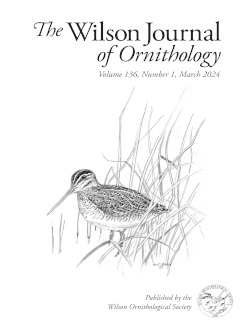Eggshell thickness can be an indicator of environmental pollution in wild birds and shell quality in wild and domestic birds, but it is difficult to measure calcite eggshell thickness due to the presence of the adherent outer eggshell membrane. Eggshells of 13 waterbird species were divided in half longitudinally and the outer membrane was removed from one of the halves. Subsequently, we measured eggshell thickness, both with and without the outer eggshell membrane, using a Hall-effect thickness gauge to the nearest 0.001 mm along the equator of each eggshell half. Outer eggshell membrane thicknesses ranged from 0.014 to 0.073 mm. Caspian Tern (Hydroprogne caspia) and California Gull (Larus californicus) had the thickest eggshell membranes (0.056 and 0.073 mm, respectively), and Green Heron (Butorides virescens) and Killdeer (Charadrius vociferus) had the thinnest membranes (0.014 and 0.022 mm, respectively). The eggshell membrane, as a percent of the total eggshell and membrane thickness, varied among the 13 species and ranged among species from 7.9% to 20.6%. The outer membrane comprised a greater percent of the total eggshell and membrane thickness for Black Skimmer (19.3%; Rynchops niger), California Gull (20.5%), and Forster's Tern (20.6%; Sterna forsteri) than for Green Heron (7.9%), Double-crested Cormorant (10.4%; Phalacrocorax auritus), and Western Grebe (10.6%; Aechmophorus occidentalis). Within species, the outer membrane thickness was not correlated with egg morphometrics but, for a subset of species, there was some indication that the calcite eggshell thickness decreases with embryo development (age). We discuss several reasons for conducting future eggshell thickness measurements without removing the membrane.
El grosor de la cáscara de huevo puede ser indicador de la contaminación ambiental en aves silvestres y de calidad de la cáscara tanto en aves silvestres como domésticas, pero es difícil medir el grosor de la calcita de la cáscara de huevo por la presencia de la membrana externa adherente. Cáscaras de huevos de 13 especies de aves acuáticas fueron divididas en mitades longitudinales y la membrana externa fue removida de una de las dos mitades. Luego medimos el grosor de las cáscaras de huevo, tanto con como sin membrana externa, usando calibrador de grosor de efecto Hall con al 0.001 mm más cercano, próximo al ecuador de cada mitad de la cáscara de huevo. El grosor de la membrana externa varió entre 0.014 to 0.073 mm. El charrán Hydroprogne caspia y la gaviota Larus californicus tuvieron las membranas más gruesas (0.056 and 0.073 mm, respectivamente), mientras que la garcita verde (Butorides virescens) y el chorlo Charadrius vociferus tuvieron las membranas más delgadas (0.014 y 0.022 mm, respectivamente). La membrana del cascarón como porcentaje de la suma del grosor del cascarón y de la membrana, varió entre las 13 especies de 7.9% a 20.6%. La membrana externa representó un mayor porcentaje del grosor total de cáscara de huevo y membrana para rayador Rynchops niger (19.3%), la gaviota (20.5%) y el charrán Sterna forsteri (0.6%) que para la garcita verde (7.9%), cormorán Phalacrocorax auritus (10.4%) y archichilique Aechmophorus occidentalis (10.6%). Dentro de las especies, el grosor de la membrana externa no estaba correlacionado con la morfometría del huevo pero, para un subconjunto de especies, hubo algunos indicios de que el grosor de la calcita de la cáscara de huevo disminuyó con el desarrollo del embrión (edad). Discutimos varias razones para llevar a cabo mediciones futuras de grosor de cáscara de huevo sin remover la membrana.
Palabras clave: medida de cáscara de huevo, membrana de cáscara de huevo, grosor de cáscara de huevo, calibrador de grosor de efecto Hall.





